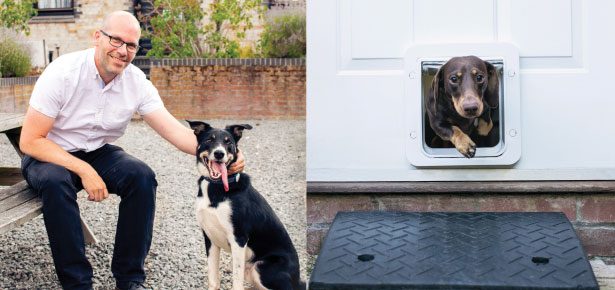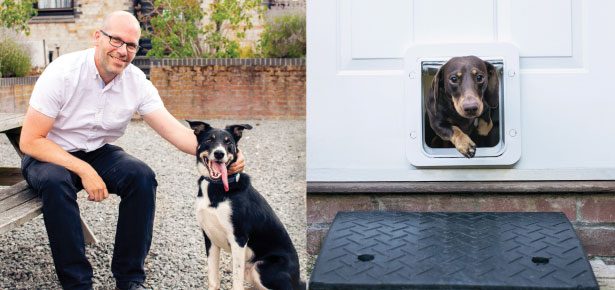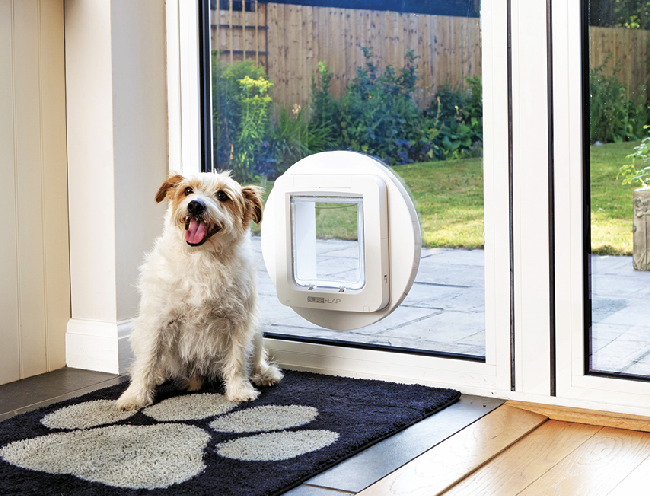

I Invented That!
How a childhood love of Lego led a Cambridge physicist to create a next-level pet door and a Fitbit for dogs
Like many kids who grew up before the Internet, Dr. Nick Hill either played outdoors or built stuff indoors with his Meccano set and Lego. “I also took things apart to see how they worked but they didn’t always get put back together,” says Nick, laughing. At age 12 he built a Lego mechanical dog that walked across the living room floor. “My mum remembers that dog. Little did we know that it might have been my calling.” Fast forward about three decades. Nick was working at a design agency called NXT on product development when they incorporated Lego into a prototype. Inspired, that very night Nick revisited his old Lego set and started working on a pet door in order to solve a personal problem…
Flipper the Cat
If necessity is the mother of invention, then Flipper the cat is responsible for the pet door Nick invented. Flipper’s existing standard-issue cat door provided him freedom, but at a cost—neighbourhood cats were coming in uninvited and stressing him out. As soon as Nick’s new door was installed, “Flipper was much more relaxed.”
Nick was convinced that the cat flap he had created, which put to use radio-frequency identification (RFID) technology, was a great idea. There was a lot of hype at the time around RFID technology, which uses electromagnetic fields to automatically identify and track tags attached to objects. The RFID tags contain electronically-stored information and are used in many industries to track products, from cars to pharmaceuticals. And implanting RFID microchips in livestock and pets allows for positive identification of animals. Nick saw that RFID had a wide-scale application, lots of publicity, and growth potential.
Furthermore, at NXT, Nick had developed a new kind of touch screen that was so successful he only needed to work part-time. This allowed him the bandwidth to start a new venture of his own. He was off and running: he had a product idea in a hot tech area and no one else had made that product—or so he thought. With a standard electronics kit from the hardware store, Nick turned the spare bedroom into his workspace. Fortunately his wife Jane was supportive. “She had a good job and supported our family in this enterprise so it was a joint decision, and she helped on the business side,” explains Nick.
Nick says his three boys are also inspirational—these budding entrepreneurs and Lego fans are at that age (the oldest is nine and twins are eight) where they outsmart you. They constantly come up with ideas for inventions. “After the cat flap door was on the market they said I should make one for dogs, so we did,” adds Nick. “One boy came up with glasses for cats after I told them how they can’t focus when they get close to prey and their whiskers take over.” Not every idea can be a bestseller.

But Were There Other Patents?
Nick admits he wasn’t the first person to imagine a pet door operating from a microchip. It’s always a good idea—from the get-go—to see where your product stands regarding Intellectual Property (IP). “Someone had already come up with the idea and had disclosed it publicly,” says Nick,” but the patent had lapsed and it wasn’t taken to the final product phase.” He saw this as good news, however, because a concept is not protected and there was no product because it was a difficult technical problem. But how would he get from a pure idea to a physical product? And were there other patents?
Nick has some background in IP so that worked out well: you can do a lot with free tools and search patents. As well, he was confident that it could be built, but it wasn’t going to be easy; microchips are designed to be small and implantable, not to operate a pet door. “I stayed up at night thinking of ways to solve the problem, but I wasn’t worrying. It was a cool idea with mass market application; it was possible but technically hard to do,” Nick says. “For me, this spelled a great start to create a successful business.”
Recipe for Success
Figuring out the technology took about a year. Nick never became disenchanted; he was confident and convinced it was going to be a success. But halfway through the development phase, after the technical problems were solved and he was into design mode, someone else launched a similar product. This product, however, had a reader that was outside of the door and you had to plug it in rather than run on batteries. “I immediately bought one, ripped it apart and knew I would be fine,” he says. “I was going to produce a pet door without compromise.” When Nick launched his product a year later, it took the majority of the market. He had developed a new RFID technology called OnTune, offering greatly improved read range for a given battery life and enabling new use of the pet microchip.
Future Products
The finished flap, given the name the SureFlap Microchip Cat Flap, was just the first in a line of multi award-winning pet products developed in the past decade. There’s the SureFlap Microchip Pet Door, with automated curfew mode (owners don’t have to get up in the small hours to let their pets out or can restrict exit at night) for larger cats and small dogs. And SureFeed, which is a Microchip Pet Feeder that enables portion control for pets on weight management diets and individual-specific access for pets on prescription drugs, stopping them from stealing each other’s food.
“When you look at trends, in general people are getting busier. Combining good pet care with modern life is a challenge and that is where our future products are focused,” says Nick. “For instance, Flipper’s door monitors every time he goes in and out of the house and my phone meows when he goes through the door. It’s all about piece of mind: I know Flipper is safe when I’m at work because I know his normal routine.” Weigh scales under the feeder bowl indicate how much food your pet has eaten, so “with the feeder, I know Flipper is eating the right amount of food.”
A behaviour monitor for dogs was launched this August 2018. Nick says this “Fitbit for dogs” does a whole lot more than recording running, eating and sleeping. “It monitors shaking and scratching and barking; when your dog was last fed and exercised, and how many calories pooch burned yesterday,” he adds. “It’s not being obsessive. It’s more like a ‘clip and forget’ that you put on your dog’s collar. We see this as a powerful tool, and the future in quality pet care.”
Sureflap products are available at amazon.com and direct from Nick’s company surepetcare.com.
Join the newsletter and never miss out on dog content again!
"*" indicates required fields
By clicking the arrow, you agree to our web Terms of Use and Privacy & Cookie Policy. Easy unsubscribe links are provided in every email.